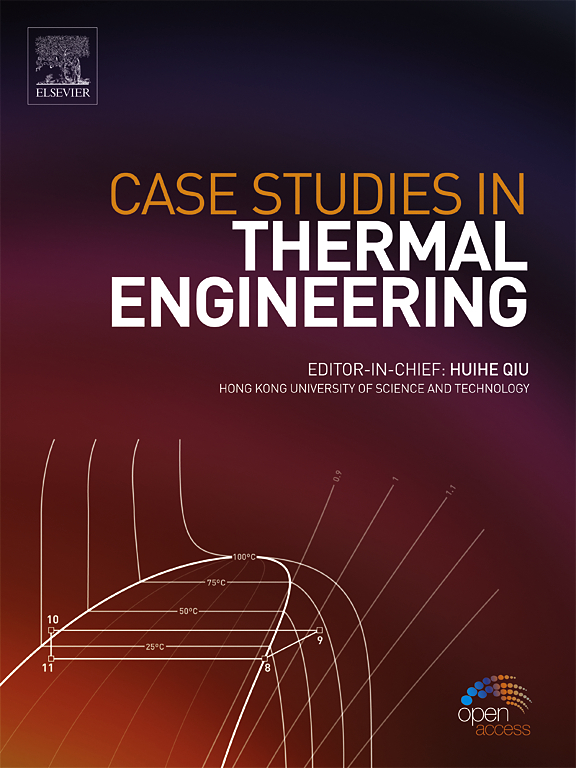Numerical simulation of co-firing LRC and ammonia in Pangkalan Susu 3 & 4 coal-fired steam power plant (CFSPP) capacity 210 megawatts
IF 6.4
2区 工程技术
Q1 THERMODYNAMICS
引用次数: 0
Abstract
The effort to reduce CO2 and NOx emissions plays a crucial role in mitigating climate change, improving air quality, complying with environmental regulations, and promoting clean technology innovation. Ammonia, as an emission-free fuel, shows significant potential as a co-firing agent with Coal in coal-fired steam power plants (CFSPP). Previous studies have demonstrated promising results in emission reduction through ammonia co-firing. This research presents a numerical analysis based on Computational Fluid Dynamics (CFD) to investigate the co-firing of ammonia with low-calorific Coal (LRC) in the CFSPP Pangkalan Susu Units 3 and 4, with a capacity of 210 MW. The study employs fluid flow modelling and chemical reaction analysis using the Discrete Phase Model (DPM) to provide accurate predictions of temperature distribution and pollutant concentrations in pulverized coal boilers. Cofiring simulations were conducted with ammonia additions of 5 % and 15 % on a calorific basis. Injection experiments from each burner (A-D) were performed to identify the optimal injection location. The simulation results indicate changes in combustion characteristics, particularly in temperature distribution. The main finding reveals a temperature decrease when ammonia is added as a co-firing material, attributed to the higher H2O content, which leads to increased moisture losses. In terms of efficiency, co-firing showed a decline compared to the baseline combustion of 100 % LRC coal due to the more significant moisture losses. The highest reduction in CO2 emissions was observed when 15 % ammonia was injected from burner B in case #6, with a mass fraction value of 0.171 at the boiler outlet. Similarly, the most significant reduction in NOx emissions occurred with a 15 % ammonia co-firing from burner B, yielding a mass fraction value of 8.81E-04 at the boiler outlet. This co-firing technology is expected to enhance decarbonization efforts and optimize the use of renewable energy in the future.
庞卡兰苏苏 3 号和 4 号燃煤蒸汽发电厂(CFSPP)210 兆瓦发电量中 LRC 和合成氨联合燃烧的数值模拟
减少二氧化碳和氮氧化物排放的努力在减缓气候变化、改善空气质量、遵守环境法规和促进清洁技术创新方面发挥着至关重要的作用。氨作为一种无排放燃料,在燃煤蒸汽发电厂(CFSPP)中作为煤的联合燃烧剂显示出巨大的潜力。以往的研究表明,氨气联合燃烧在减排方面取得了可喜的成果。本研究基于计算流体动力学(CFD)进行了数值分析,以研究在装机容量为 210 兆瓦的 CFSPP Pangkalan Susu 3 号和 4 号机组中氨与低热值煤(LRC)的联合燃烧。该研究采用离散相模型 (DPM) 进行流体流动建模和化学反应分析,以准确预测煤粉锅炉中的温度分布和污染物浓度。在氨添加量为 5% 和 15% 的热量基础上进行了联合燃烧模拟。对每个燃烧器(A-D)进行了注入实验,以确定最佳注入位置。模拟结果显示了燃烧特性的变化,尤其是温度分布的变化。主要发现是由于 H2O 含量较高,导致水分损失增加,因此在添加氨作为联合燃烧材料时温度会降低。在效率方面,由于水分损失更多,与 100% LRC 煤的基准燃烧相比,联合燃烧的效率有所下降。在案例 6 中,当从燃烧器 B 中喷入 15% 的氨时,二氧化碳排放量减少最多,锅炉出口处的质量分数值为 0.171。同样,从燃烧器 B 中喷入 15% 的氨气时,氮氧化物排放量减少最明显,锅炉出口处的质量分数值为 8.81E-04。这种联合燃烧技术有望在未来加强去碳化工作,优化可再生能源的使用。
本文章由计算机程序翻译,如有差异,请以英文原文为准。
求助全文
约1分钟内获得全文
求助全文
来源期刊

Case Studies in Thermal Engineering
Chemical Engineering-Fluid Flow and Transfer Processes
CiteScore
8.60
自引率
11.80%
发文量
812
审稿时长
76 days
期刊介绍:
Case Studies in Thermal Engineering provides a forum for the rapid publication of short, structured Case Studies in Thermal Engineering and related Short Communications. It provides an essential compendium of case studies for researchers and practitioners in the field of thermal engineering and others who are interested in aspects of thermal engineering cases that could affect other engineering processes. The journal not only publishes new and novel case studies, but also provides a forum for the publication of high quality descriptions of classic thermal engineering problems. The scope of the journal includes case studies of thermal engineering problems in components, devices and systems using existing experimental and numerical techniques in the areas of mechanical, aerospace, chemical, medical, thermal management for electronics, heat exchangers, regeneration, solar thermal energy, thermal storage, building energy conservation, and power generation. Case studies of thermal problems in other areas will also be considered.
 求助内容:
求助内容: 应助结果提醒方式:
应助结果提醒方式:


